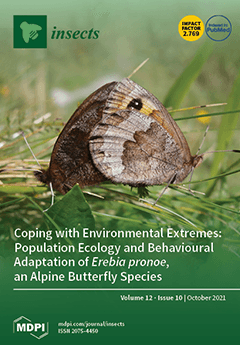The study aims to prove the possibility of colonization of
N. apis and
N. ceranae to the intestine of the greater wax moth, detect the differences of greater wax moth based on the presence of
Nosema species and examine the effect of
Nosema species on the phenoloxidase level of greater wax moth compared with honeybees. Each group was fed on the 1st day of the experiment with its appropriate diet containing 10
6 Nosema spores per insect. Each group was checked daily, and dead insects were counted. Furthermore, changes in the level of expression of the phenoloxidase-related gene after
Nosema spp. treatment on the 6th, 9th and 12th days, which was detected by Q-PCR, and the mRNA level of phenoloxidase gene were measured in all experiment groups with the CFX Connect Real-Time PCR Detection System. This study shows that
Apis mellifera L. has a 66.7% mortality rate in mixed
Nosema infections, a 50% mortality rate in
N. ceranae infection, a 40% mortality rate in
N. apis infection, while there is no death in
G. mellonella. A significant difference was found in the mixed
Nosema infection group compared to the single
Nosema infection groups by means of
A. mellifera and
G. mellonella (Duncan,
p < 0.05).
G. mellonella histopathology also shows that
Nosema spores multiply in the epithelial cells of greater wax moth without causing any death. The increase in the mRNA level of Phenoloxidase gene in
A. mellifera was detected (Kruskal–Wallis,
p < 0.05), while the mRNA level of the Phenoloxidase gene did not change in
G. mellonella (Kruskal–Wallis,
p > 0.05). These findings prove that the
Nosema species can colonize into the greater wax moth, which contributes to the dissemination of these
Nosema species between beehives.
Full article






